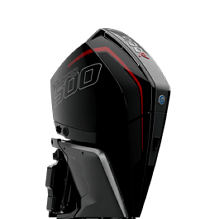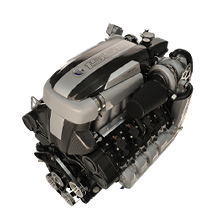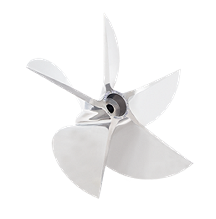Mercury Racing Blog
Prop School – Part 2: Terminology
Thu Oct 04 13:30:00 CDT 2018
Propellers are available in both right-hand and left-hand rotation. Most single engine outboard and sterndrive powered boats use right-hand rotation propellers. A right-hand rotation propeller will spin clockwise when pushing the boat forward, while a left-hand propeller will spin counter-clockwise.
Number of Blades
The most popular propellers used for recreational boating have three or four blades. Three-blade props are efficient and do a good job of minimizing vibration. Four blade props are popular for suppressing vibrations even further while improving acceleration by putting more blades in the water.
Diameter
In “prop speak,” diameter is the distance across a circle made by the blade tips as a propeller rotates. The proper diameter is determined by the power that is delivered to it and the resulting propeller rpm.
Type of application is also a factor. The amount of propeller in the water (partially surfaced vs fully submerged) plays a role in determining diameter. The more a propeller is surfacing above the water, the larger the diameter needs to be (so what’s left under water can still push). On rare occasions, diameter may be physically limited by drive type or in close, staggered engine installations where tips can touch.
Within a specific propeller style, diameter is usually larger on slower boats and smaller on faster boats. Similarly, for engines with a lower maximum engine speed (or with more gear reduction), diameter will tend to be larger. Also, diameter typically decreases as propeller blade surface areas increase (for the same engine power and rpm). A four bladed prop replacing a three blade of the same pitch will typically be smaller in diameter.
Physical limits
Mercury Racing engines fitted with the Bravo One XR or Bravo Three XR drives are designed for props up to 16-inches in diameter. Bravo One XR drives fitted with the short Sport Master gearcase accepts props up to 15-1/4 inch in diameter. Sterndrive engines with surface piercing M6 or M8 sterndrives run cleaver props up to 18-inches in diameter. Our 4.6L V-8 250R and 300R FourStroke outboards as well as the 400R Verado accept props up to 16-inches in diameter.

Pitch is the distance a propeller would move in one revolution if it were moving through a soft solid, like a screw in wood. When we list an outboard four-blade Pro Max prop as a 14-1/2 X 32, we are saying it is 14-1/2 inches in diameter with 32-inches of pitch.
Pitch is measured across the face of a propeller blade. Actual pitch can vary from the pitch number stamped on the prop. Modifications made by propeller shops may alter the pitch. Undetected damage from a submerged object may result with a bent blade, altering the pitch as well.
There are two common types of pitch; constant and progressive. Constant pitch means the blade pitch is the same – from the leading edge to trailing edge. Progressive pitch, referred to as blade camber, starts low at the leading edge and progressively increases toward the trailing edge. The pitch number, “32” in the Pro Max example, is the average pitch over the entire blade.
Pitch is like another set of gears. Since an engine needs to run within its recommended maximum rpm range, proper pitch selection achieves that rpm. The lower the pitch, the higher the engine rpm. Mercury Racing propellers are designed so that a one-inch change in pitch results in a 150 rpm change in engine speed.
A lower pitch propeller may provide greater acceleration for water sports activities, but your top speed and fuel efficiency may suffer. If you run at full throttle with a prop selected for acceleration and not top-end speed, your engine rpm may be too high, placing an undesirable stress on the engine. If you select too high of a pitch, your engine may lug at a lower rpm – which can also cause damage. Acceleration will be slower as well. It will be reduced further with a full load of fuel and maximum capacity of people on board.
Proper pitch selection allows the engine to operate near the top of its recommended rpm range at light load (1/2 fuel tank and two people). Using this pitch selection method, the engine usually operates near the low end of the recommended engine operating range when the boat is fully loaded (full fuel tank, boating gear, full live wells, and maximum capacity). Full load engine speed is usually reduced 200 to 300 rpm. The power output of naturally aspirated engines can be affected by high heat and humidity which is another factor that can reduce engine speed by 200 to 300 rpm.
The Mercury Racing Prop Slip Calculator App is very helpful in determining the proper pitch for your application.
Smart, pressure charged engines like the supercharged 400R outboard and our turbocharged QC4 sterndrives will auto-regulate power output for heat and humidity. Adaptive Speed Control, a standard feature on our 250R and 300R outboards, is another factor to consider when dialing in your boat for maximum power and top-end speed.
In my next Prop School post, I will discuss blade rake.


